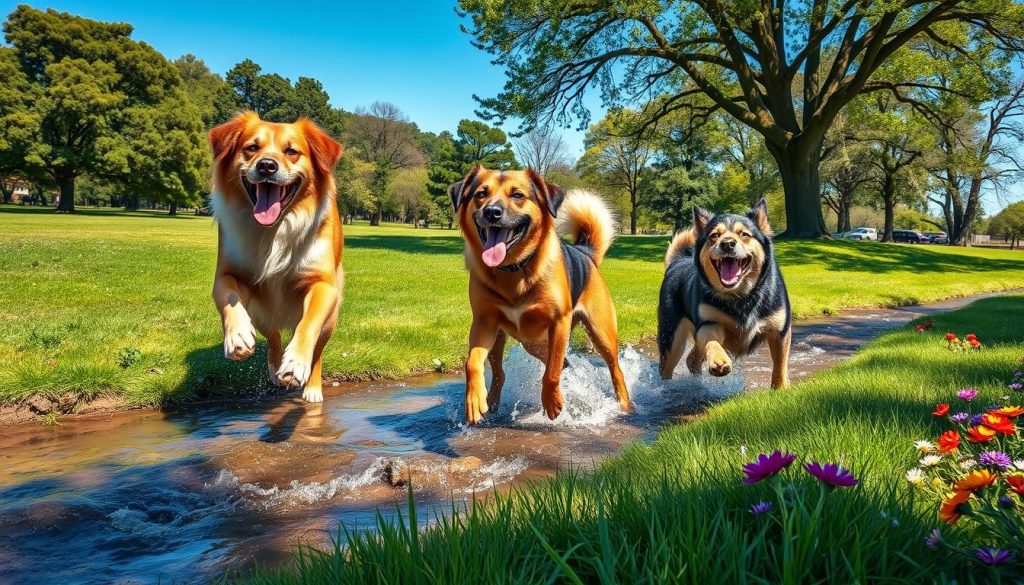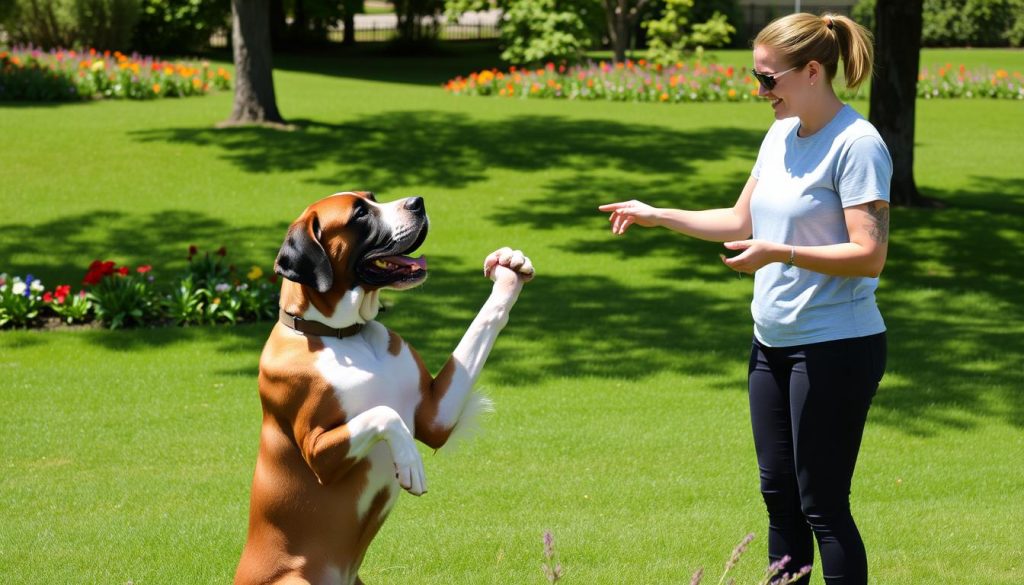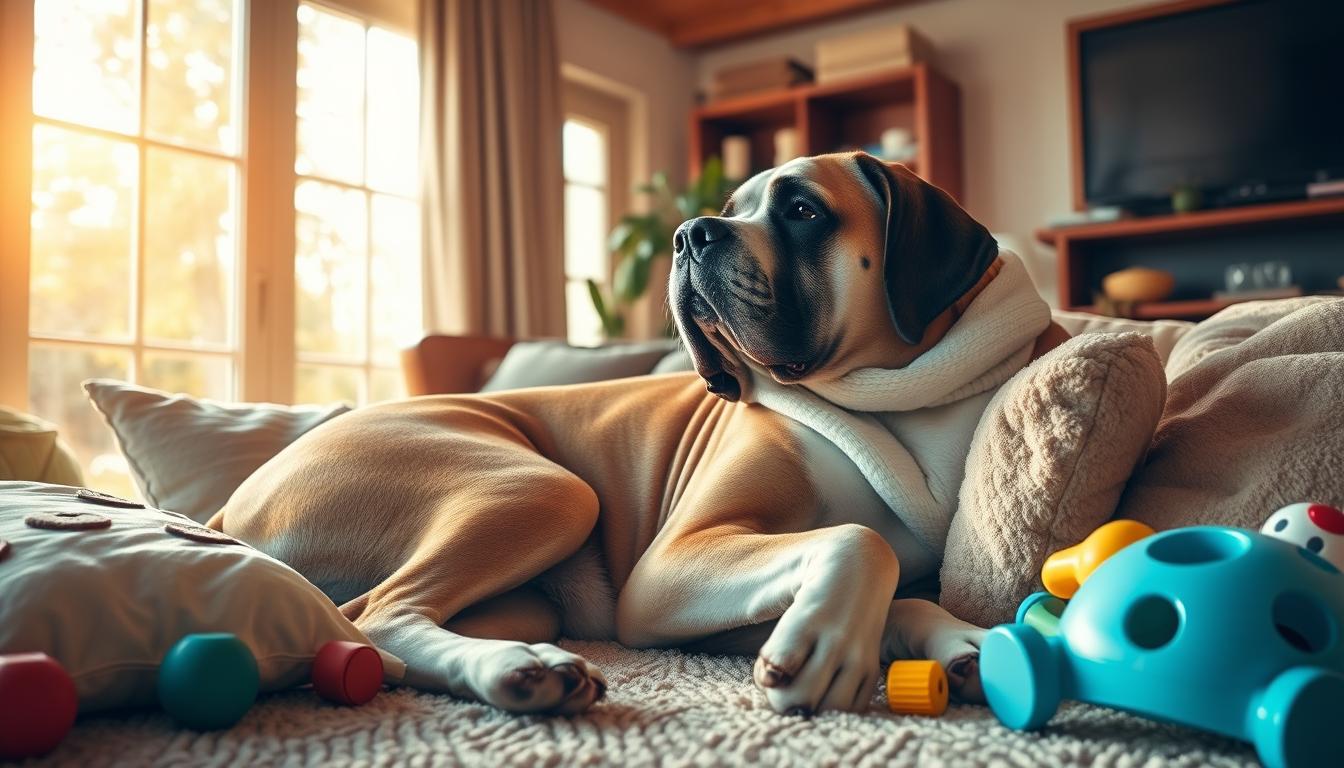Thinking about adding a furry friend to your family? Consider a gentle giant. Dogs like Great Danes or Newfoundlands are often overlooked because of their size. But, as a proud owner of a massive canine, I can tell you they’re the best family pets.
Giant dog breeds may look intimidating, but they have huge hearts. They are calm, protective, and loving, making them perfect for families with kids. In this article, I’ll share my experiences and why these dogs are great for families.
Understanding What Giant Dog Breeds Are
Large breed dogs, like Great Danes and Mastiffs, are truly impressive. They can weigh over 100 pounds and stand taller than many people. But what makes a dog a giant breed?
Characteristics of Giant Dog Breeds
Giant dog breeds are known for their huge size. They are at least 30 inches tall and can weigh 100 to 200 pounds or more. Despite their size, they are often very gentle and loyal.
Common Breeds and Their Traits
Some popular giant dog breeds include:
- Great Danes: Known for their friendly nature, Great Danes are great with families. They are patient with kids and calm.
- Mastiffs: These dogs are protective and loyal. They are gentle with their families but cautious around strangers.
- Newfoundlands: These dogs are sweet and love water. They are perfect for families with kids.
- Irish Wolfhounds: Known for being tall, Irish Wolfhounds are athletic and kind. They are smart and easy to train.
Owning a giant dog breed can be very rewarding. However, it’s crucial to understand their needs before bringing one home. They need lots of space, exercise, and training. But for the right family, they are unforgettable companions.
The Family Benefits of Having a Giant Dog
Bringing a Mammoth Mutt, Colossal Canine, or Heavyweight Housemate into your home can fill it with joy and love. Despite their large size, these dogs are gentle and loving. They bring comfort and security to your family.
Their Gentle Nature
Giant dog breeds are known for their gentle and patient nature. They can sense when their family needs them, offering calm and support. They are great with kids, being patient and loving to play.
Protective Instincts
Heavyweight Housemates are friendly but also protective of their family. They naturally watch over their loved ones, acting as guardians. Their size can even scare off intruders, giving your family peace of mind.
Space Considerations for Giant Dog Breeds
Thinking about getting a giant dog breed like an oversized hound or a Saint Bernard? It’s key to check if your home is big enough. These big dogs need lots of space to move and be happy.
Ideal Living Environments
Giant dogs do best in homes with lots of room inside and a big, fenced yard. Small places like apartments can be too tight for them. Here’s what to look for in your home:
- Open floor plans that allow for easy navigation
- Sturdy furniture that can withstand the occasional bump or lean
- Non-slip flooring to prevent accidents and injuries
Backyard Needs for Larger Breeds
A big, safe backyard is essential for giant dogs. Oversized hounds and Saint Bernards need space to run and play. Think about these things for your yard:
- Ensure the fence is tall enough to prevent jumping over
- Provide shaded areas for rest and relaxation
- Install a doggy door for easy access to the indoors
- Create a designated area for digging and other outdoor activities
With the right home and yard, your giant dog will be happy and healthy. They’ll be a great part of your family.
Exercise Needs of Giant Dogs
Our giant dogs need lots of exercise to stay healthy and happy. These big dogs, despite their size, need to move to stay fit and mentally sharp. Let’s look at what they need and find fun ways to keep them active.

Daily Activity Requirements
Different giant dog breeds need different amounts of exercise. But most need at least 30 minutes to an hour of activity each day. You can split this into shorter walks and playtimes.
Even though they might not be as bouncy as smaller dogs, they still need to stay active. This helps them keep a healthy weight, strong muscles, and a good heart. Regular exercise also stops them from getting bored or restless.
Fun Activities to Engage Them
To keep your mammoth mutt excited about exercise, mix up their activities. Here are some fun ideas:
- Long walks or gentle hikes in nature
- Swimming or playing in water (if your dog enjoys it)
- Fetch games with large, durable toys
- Tug-of-war with a sturdy rope or toy
- Nose work games or scent-based activities
- Obedience training or trick training sessions
Always watch your giant dog during playtime. Choose activities that fit their age, health, and energy. With daily exercise and fun activities, your big dog will stay happy and healthy for many years.
Grooming and Maintenance of Giant Breeds
Welcoming a Sizeable Fur Baby into your home means understanding their grooming needs. These gentle giants need regular care to keep their coats healthy. As an Oversized Hound owner, I’ve learned the value of a consistent grooming routine.
Coat Care and Shedding
Giant dog breeds have thick, lush coats that need brushing to prevent matting. Breeds like the Newfoundland and the Leonberger shed a lot, especially in seasonal changes. Brushing your Sizeable Fur Baby at least twice a week helps manage shedding and keeps your home fur-free.
Regular baths are key for your giant dog’s coat health. But, don’t overdo it, as too much bathing can harm their skin. I bathe my Oversized Hound every 6-8 weeks with a gentle, dog-specific shampoo.
Regular Health Check-Ups
Regular health check-ups are crucial for giant dog breeds. They can be prone to health issues like hip dysplasia and heart conditions. Annual vet visits help catch and manage health problems early.
As a responsible owner, I keep my Sizeable Fur Baby’s vaccinations up-to-date. I also ensure they get preventive treatments like flea and tick control. Regular dental check-ups and cleanings are vital for their health and to prevent dental problems.
Training Tips for Giant Dog Breeds
Training your giant dog early and consistently is key. They may look big and scary, but they can learn to be great family pets. With the right training, they’ll become well-behaved and loving.

Importance of Early Socialization
Socializing your giant dog early is vital. It helps them grow into confident, well-adjusted adults. Here are some ways to socialize your dog:
- Taking them to puppy classes
- Visiting dog-friendly parks and stores
- Inviting friends and family over to meet your pup
Effective Training Techniques
Use positive reinforcement when training your dog. Give them treats and praise for good behavior. Avoid punishing them for mistakes. Here are some effective training methods for giant breeds:
- Clicker training
- Leash training
- Basic obedience commands (sit, stay, come)
Consistency is crucial in training your dog. Set clear rules and stick to them. With patience and effort, your giant dog will become a loving family member.
My Personal Experience with a Giant Dog
As a proud owner of a Massive Canine Companion, I’ve seen an amazing bond form. My experience with my giant dog has been filled with love, laughter, and some challenges.
The Bond I Developed
From the start, I knew our connection would be special. These dogs sense and respond to human emotions. My gentle giant became my loyal companion, always there for me.
Our bond is more than just a typical dog-owner relationship. It’s built on trust, understanding, and loyalty. My giant dog has shown me the true meaning of unconditional love.
Challenges We Overcame Together
Owning a giant dog comes with unique challenges. Finding the right living space and managing their exercise needs are key. It’s important to be ready for the responsibilities.
Training was a challenge. Giant dogs can be strong-willed, but with patience and positive reinforcement, we overcame it. We formed a strong bond in the process.
Ensuring my giant dog got enough exercise and mental stimulation was another challenge. We found a balance with daily walks, playtime, and interactive toys.
Through every challenge, my giant dog has been my faithful companion. Our bond shows the incredible relationship humans and these Massive Canine Companions can have.
Giant Dogs and Children: A Perfect Match
Large breed dogs, like the Saint Bernard, are great for families with kids. They are big but very patient and caring. This makes them perfect friends for children of any age.

It’s key to build trust between a big dog and kids. Watch them together at first and teach kids how to be gentle. Tell them not to pull the dog’s ears or tail and never wake them up while they’re sleeping.
Teaching Kids to Interact Safely
It’s important to teach kids how to safely play with a big dog. Here are some rules to follow:
- Always ask permission before petting the dog
- Avoid sudden movements or loud noises that may startle the dog
- Never climb on or try to ride the dog
- Give the dog plenty of space and respect their boundaries
Teaching kids how to safely play with a big dog helps everyone get along. With the right guidance, a Saint Bernard can become a child’s best friend. They will create memories that will last forever.
My Favorite Giant Dog Breeds for Families
Giant dog breeds are often the best choice for families. They bring joy and companionship to any home. Here are some of my favorites that are perfect for families.
The Great Dane is a top pick for me. They are known as “gentle giants” because of their kind nature. Great Danes are huge but love their families and are very patient with kids. They are a pleasure to have around.
Breeds That Are Great with Kids
I also recommend the Mastiff for families. These dogs are loyal and protective. They bond strongly with their family and are patient with kids. Mastiffs are great guardians and friends.
Traits That Make Them Ideal Companions
Giant dog breeds have traits that make them perfect for families:
- Gentle and patient nature
- Protective instincts towards family members
- Adaptability to various living situations
- Loyalty and deep affection for their humans
With the right training and socialization, these breeds are amazing family pets.
Myths and Misconceptions About Giant Breeds
Many myths surround Mammoth Mutts and Heavyweight Housemates. As a proud owner, I aim to clear up these misconceptions. I want to show that these dogs are not scary, but loving companions.
Debunking Size-Related Fears
One common myth is that giant dogs are aggressive. But, this is not true. Mammoth Mutts are incredibly gentle and loving. They want to protect their family, but they’re not aggressive by nature.
Another myth is that giant dogs need too much space. While they do need more room, they can adapt to different living situations. With enough exercise and playtime, they can thrive in apartments too.
Understanding Their Temperament
Giant dog breeds are calm and even-tempered. They are patient, loyal, and eager to please. These traits make them great family dogs, especially with children.
Remember, every dog is unique. Their temperament can be shaped by breeding, socialization, and training. It’s important to spend time with a giant breed before bringing them home. This ensures they fit well with your family and lifestyle.
Conclusion: Embracing Giant Dog Breeds in Family Life
We’ve looked at the great qualities of massive dogs as family pets. They are gentle, protective, loving, and loyal. These traits make them a joy to have around.
Why You Should Consider One
If you have space, time, and love, a giant dog could be a great choice. They are calm, affectionate, and devoted. They are perfect for families with kids.
Seeing your kids and their dog become close is heartwarming. It’s a memory you’ll always treasure.
Final Thoughts on the Joys of Giant Breeds
Living with a giant dog is an adventure. It’s filled with laughter, hugs, and love. They make every day brighter with their presence and loyalty.
If you welcome a giant dog into your home, get ready for a deep bond. You’ll make many happy memories together. Discover the love and happiness giant dogs bring to your family.

